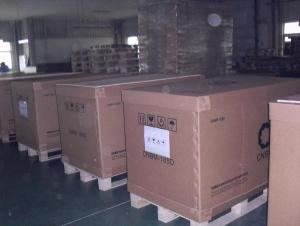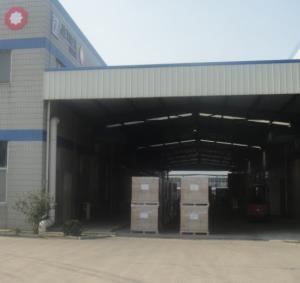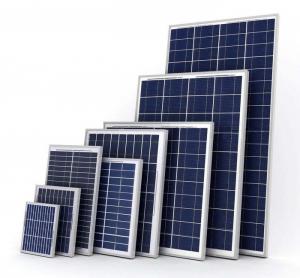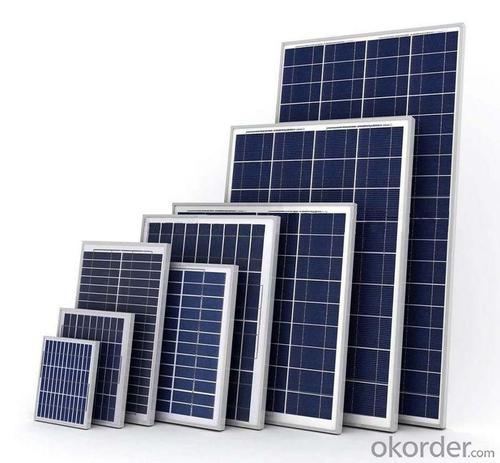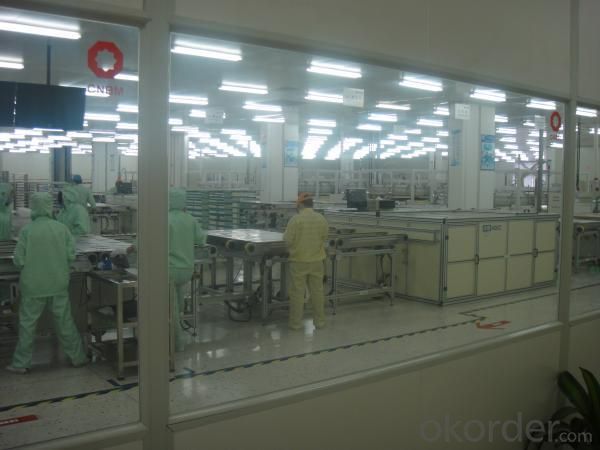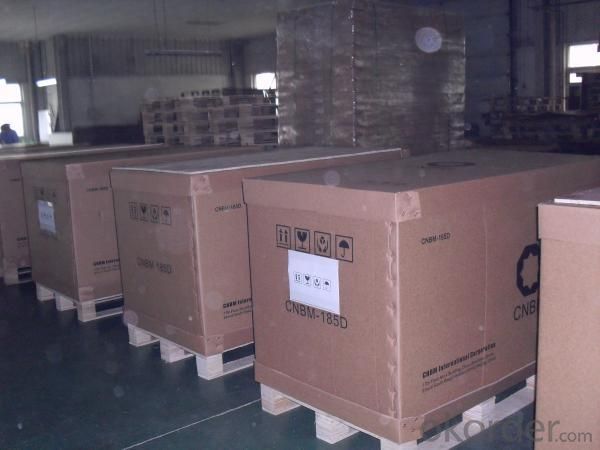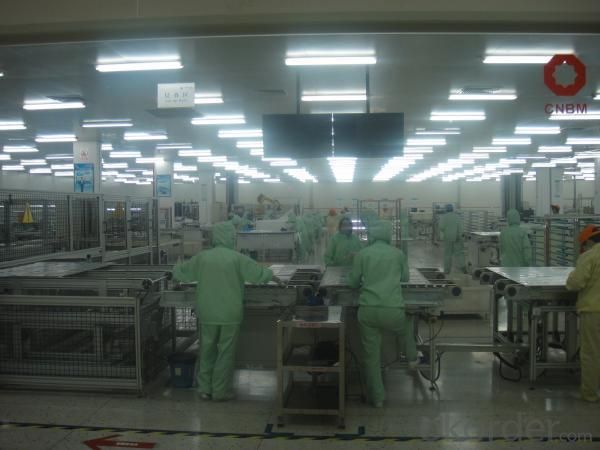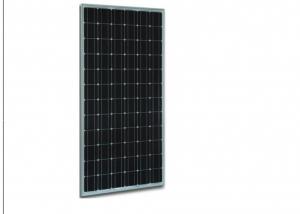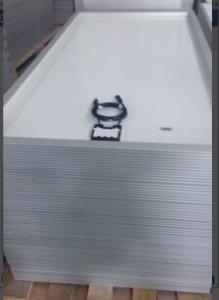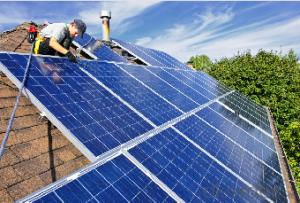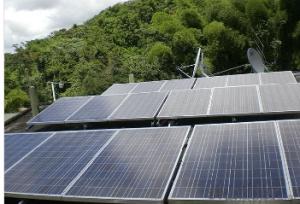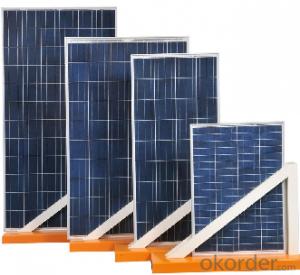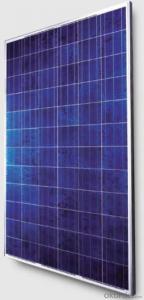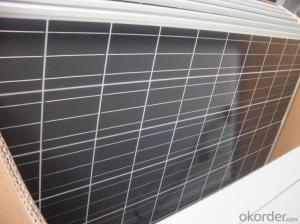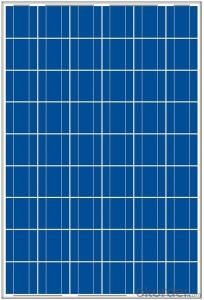American Made Polycrystalline Solar Panels
- Loading Port:
- Shanghai
- Payment Terms:
- TT or LC
- Min Order Qty:
- 40 watt
- Supply Capability:
- 200000 watt/month
OKorder Service Pledge
OKorder Financial Service
You Might Also Like
Details Of Polycrystalline Solar Panel (25W—310W)
CNBM Solar photovoltaic (PV)module is designed for large electrical power requirements.
It is the optimal choice for both on-grid and off-grid power systems.
CNBM Solar panel offers high performance of power per square foot of solar array.
Poly- or multicrystalline silicon(poly-Si or mc-Si): made from cast square ingots — large blocks of molten silicon carefully cooled and solidified.
Poly-Si cells are less expensive to produce than single crystal silicon cells, but are less efficient.
US DOE data shows that there were a higher number of multicrystalline sales than monocrystalline silicon sales.
Main Features of Polycrystalline Solar Panel (25W—310W)
I Solar Cell : High efficiency crystalline solar cell. Even if under the weak light, the solar module can produce maximum power output.
II Tempered glass (toughened glass): Anti-reflecting coating and high transmission rate glass increase the power output and mechanical strength of solar module.
III EVA and TPT: Using high quality EVA and TPT to prevent destroying and water.
IV AI frame: Without screw, corner connection. 6 holes on the frame can be installed easily.
V Junction box: Multi function junction box with water proof.
VI Long lifetime: ≥25 years; Less power decrease.
VII Good performance of preventing from atrocious weather such as wind and hails.
Temperature Coefficient of Polycrystalline Solar Panel (25W—310W)
NOCT | 47℃±2℃ |
Temperature Coefficients of Isc (%/℃) | 0.064 |
Temperature Coefficients of Voc (%/℃) | -0.33 |
Temperature Coefficients of Pmp (%/℃) | -0.45 |
Operating Temperature | –40 °C to +85°C |
Storage Temperature | –40 °C to +85°C |
Max System Voltage | 700V |
Products Guarantee | 2 yrs free from defects in materials and workmanship |
Performance Guarantee | No less than 90% within 10yrs and no less than 80% within 20yrs |
Certificates | ISO, TUV, CE |
Standard Test Conditions of Polycrystalline Solar Panel (25W—310W)
The opto-electrical specifications shown below are stabilized values being measured at Standard Test Conditions of multicrystalline silicon Solar Panel, Irradiance: 1000W/m2, Spectrum: AM1.5 at 25°C, The info below is subject to manufacturing tolerances. Where appropriate minutes of measurement are available and are used for the dimensioning of the installation.
Advantages of Polycrystalline Solar Panel (25W—310W)
• CNBM Solar performance guarantees for 25 years
• 12 years guarantee for workmanship for multicrystalline silicon Solar Panel
• Timeliness of delivery
Images of Polycrystalline Solar Panel (25W—310W)
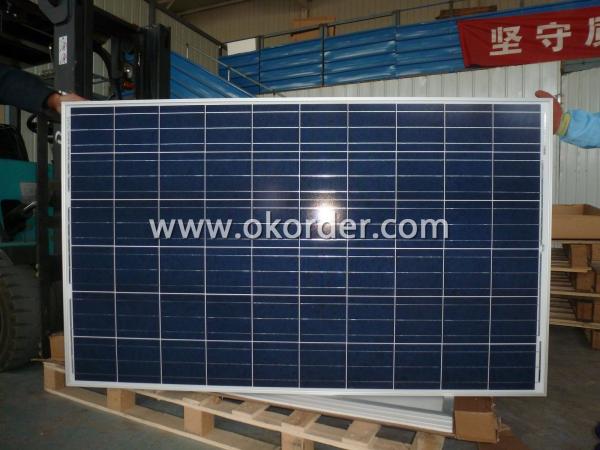
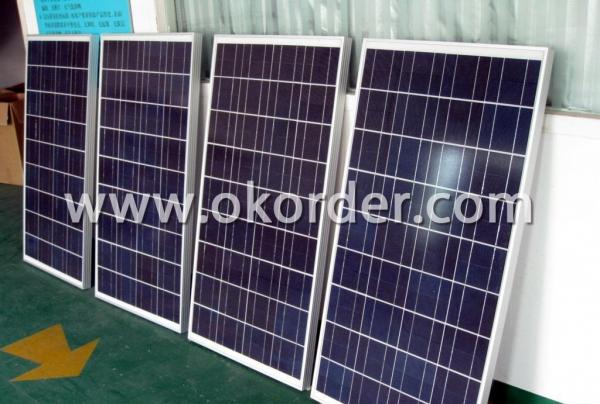
Our Services
1. OEM service is welcome.
2. We will provide all the details to you during the mass production.
3. Customize your mould according to your need.
4. Your requirements and complaints are highly respected.
5. Necessary test and certification can be obtained as your request.
FAQ about Polycrystalline Solar Panel (25W—310W)
1. Q: How do I pay for my purchase order?
A: T/T, L/C at sight
2. Q: How can I get sample and how long will it takes?
A: Sample fee will doutbed, but we will return the extra money after you place an order to us, It usually takes 1-3days to produce a sample.
3. Q: What's the MOQ?
A: Depend customer's demand.
4. Q: What's the time delivery?
A: It will take about 5-10 days to finish an order. But the exact time is according to actual situation.
5. Q: Can I have my own customized product?
A: Yes, your customized requirements for color, logo, design, package,shipping marks etc are available.
6. Q: Do you have quality control?
A: Yes, we take great control of the quality.
7. Q:How about the quality?
A: 25 Years.
- Q: Are solar panels easy to maintain?
- Yes, solar panels are generally easy to maintain. They have no moving parts and require minimal upkeep. Occasional cleaning to remove dust and debris is recommended, and regular inspections to ensure proper functioning are necessary. However, overall, the maintenance requirements for solar panels are quite low compared to other energy systems.
- Q: I am trying to built a circuit that will power two USB ports (both 5V and 0.5 amps) from the output of a solar panel that produces 20V at 0.2 amps. I have a voltage regulator that runs at 5v and 0.5 amps but I can't figure out the best way to boost the current up to 0.5 amps before I incorporate the voltage regulators.
- If you want to power both USB ports at the same times, It might not be possibble. Your solar panel only supplies 2.24 Watts (20V * 0.2A) of power and you need to deliver 2.5 Watts (5V * 0.5A) to the ports. Subtracting any losses from your regulator(s), you will be WAY over your power budget. You will need more of a solar panel or less of a load.
- Q: Do solar panels require a specific orientation or angle for optimal performance?
- Yes, solar panels do require a specific orientation and angle for optimal performance. Generally, it is recommended to install solar panels facing south and at an angle equal to the latitude of the installation location. This allows the panels to receive maximum sunlight throughout the day, maximizing their energy production. However, panels can still generate electricity when facing other directions or at different angles, although their efficiency may be slightly reduced.
- Q: How do solar panels affect the overall energy consumption of a building?
- Solar panels can significantly reduce the overall energy consumption of a building. By harnessing the sun's energy and converting it into electricity, solar panels provide a clean and renewable source of power. This reduces the reliance on traditional fossil fuel-based electricity, leading to lower energy bills and a reduced carbon footprint. Additionally, excess energy generated by the solar panels can be stored or fed back into the grid, further offsetting the building's energy consumption.
- Q: I was trying to figure out if I could run an electric heater off of a solar panel, but I don't understand these electric convertion factors and stuff. Would it work? (I know it'll only work in the daytime and stuff.)SOLAR PANELPeak Power 95W PTC Watts 73.0WVoc 30.7VPeak Voltage 24.4VIsc 8.6APeak Current 7.96A HEATERInput: 20 V/60 Hz ,500 W/5,200 BTU
- No, not enough power. Energetic got some of it. A transformer will not convert DC to AC. Transformers work on AC. A power inverter converts. Your solar panels do only put out the 95W but at the higher impedence of the heater, at 24V it would only be able to push through about 45W. Less than an average light bulb in a desk lamp.
- Q: If my school uses 88240kWh of electricity per month and I have 000 50W solar panels running for 6 hours a day, does it mean it will take 88240kWh / {{[(50W x 3600s)*000]/000}kWh x 6} number of hours to generate that much electricity (88240kWh)?
- running six hours a day doesn't mean much. You need to look at the solar insulation charts for your school's geographical location to come up with a better factor. The easiest number for you to use is sun hours. For example, Washington DC averages 4.23 hours. Do a Yahoo search for sun hours and you should find lots of charts. Solar panels rated at 50W give this output at full sun near noon at full brightness (no clouds). The sun hour factor makes it easy to find the equivalent number of full brightness hours. So, using Washington DC as an example you have: 000 panels * 50W * 4.23 sunhours/day = 634kWh a day on average. You state your school uses 88240kWh/month which is 6274kWh a day. This would mean you need ten times more solar panels since there is no way to get more daylight. Be careful to put in all the units in your formula and cancel them out to make sure you don't end up with a nonsense result. The title of the question would be answered as followed: 50W/000 * 4.23 sunhours/day = 0.63kWh/day or 9kWh per month or 228kWh a year. These are annual averages. If you wanted a specific month, you would need the sun hours for that month. Hope this helps.
- Q: Can solar panels be used for powering a farm or agricultural operation?
- Yes, solar panels can definitely be used to power a farm or agricultural operation. Solar energy can be harnessed and converted into electricity to meet various energy needs in the agricultural sector, such as powering irrigation systems, pumps, lighting, and other machinery. By utilizing solar panels, farmers can reduce their reliance on fossil fuels, lower energy costs, and contribute to a more sustainable and environmentally friendly operation.
- Q: Installing solar panels requires a big initial investment. Before I make this investment I want to check to see if the money I will save by installing solar panels will actually pay for this investment, in the long run. To calculate my savings, we should consider the area (square feet) I currently have available to install solar panels. Look at the available sunlight and its intensity in my state each month of the year. Based on this data estimate how much energy my solar panel will generate. Then compare that with how much energy (kWh) I currently consume based on my electricity bill.
- Only by doing the calculations (figuring out how much you electricity bill is per month now and calculate how much time it will take to get to the figure of your solar panels. Don't forget to add a couple of percentage points per year higher(since when has electrical costs gone down)? and do the addition. That is when you will pay off the solar panels, as their power is free.
- Q: so...do you think an online store dedicated to selling solar panels/systems will be a good business idea? Since green energy is the 'hottest' growing business area recently with usage growing about 30% per annum and investors putting all their money into solar energy, wind farms, biofuel, etc. I think when you sell solar systems online this will be the most appealing business model to the end customer...especially if you offer free installation on orders of say $000.
- Presently the technology is not there using green energy. Green energy is popular, but not as effecient as they claim. There is no product today whether it is electric cars, windmills, solar panels that have a lucrative payback. They all have their drawbacks. Your thinking is good, but the market and the techology just isn't there yet. If it were, you would see solar panels on every house. You already have the competition as you noted, and they aren't prospering... Good luck.
- Q: Can solar panels work during cloudy or rainy days?
- Solar panels can still generate some electricity during cloudy or rainy days, although their efficiency may be reduced. The panels can still absorb and convert diffuse sunlight into electricity, albeit at a lower rate compared to sunny days.
1. Manufacturer Overview
| Location | Nan tong,China |
| Year Established | 2008 |
| Annual Output Value | Below US$1 Million |
| Main Markets | Aisa,Afica |
| Company Certifications | TUV、CE |
2. Manufacturer Certificates
| a) Certification Name | |
| Range | |
| Reference | |
| Validity Period |
3. Manufacturer Capability
| a) Trade Capacity | |
| Nearest Port | SHANGHAI |
| Export Percentage | 1% - 10% |
| No.of Employees in Trade Department | 100 |
| Language Spoken: | CHINESE ENGLISH |
| b) Factory Information | |
| Factory Size: | |
| No. of Production Lines | |
| Contract Manufacturing | |
| Product Price Range | 4.2-5.4RMB/w |
Send your message to us
American Made Polycrystalline Solar Panels
- Loading Port:
- Shanghai
- Payment Terms:
- TT or LC
- Min Order Qty:
- 40 watt
- Supply Capability:
- 200000 watt/month
OKorder Service Pledge
OKorder Financial Service
Similar products
Hot products
Hot Searches
Related keywords


